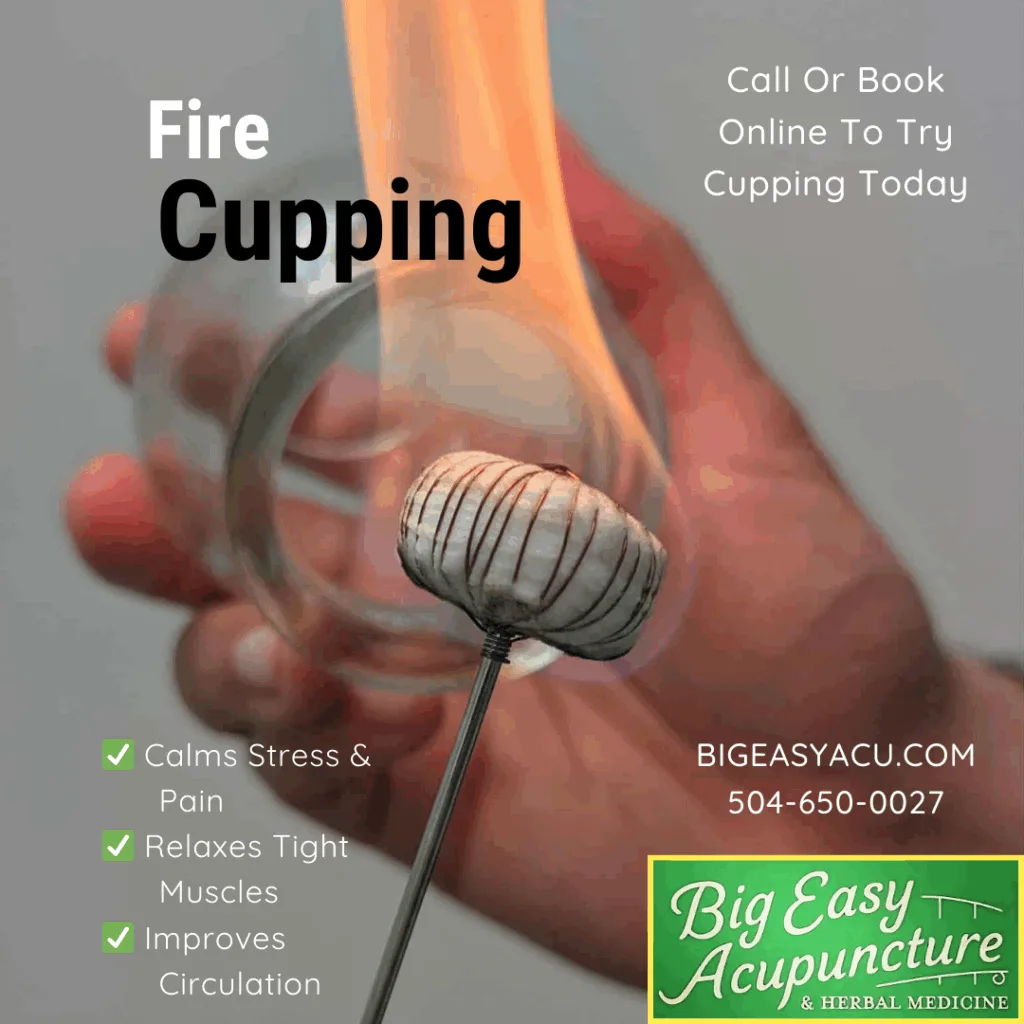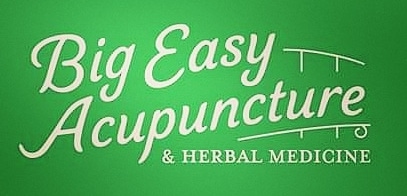
Cupping and acupuncture are a powerful combination for relieving chronic pain, muscle tightness, and tension. At Big Easy Acupuncture & Herbal Medicine in Metairie, we use cupping to help patients restore comfort, mobility, and relaxation.
You’ve probably seen professional athletes or celebrities with the telltale red circles on their skin — that’s cupping! Here’s what you need to know if you’re thinking about adding it to your acupuncture treatment.
What is Cupping?
Cupping is a technique used to stimulate acupuncture points by applying a glass, bamboo or metal cup to the skin. The suction created by the cups causes the skin and the superficial muscle layer to be drawn into the cup.
Cupping is used to:
- Improve blood flow and overall circulation
- Reduce fascial and muscle tension
- Support lymphatic and fluid movement
- Calm the nervous system
- Support recovery and relaxation
How Long does cupping take to perform?
Typically, the cups are left in place for anywhere from five to 20 minutes while you relax. Your acupuncturist might also apply oil to the skin to help the cups slide over areas needing treatment and is usually done on the back. It’s also common for your practitioner to use four, six or 10 cups depending on the severity of the condition being treated.
What Will Cupping Treat?
Frequently applied after acupuncture, cupping is used for treatment of sprains, soft tissue injuries, fluid retention in the lungs, bronchitis, congestion, asthma, and chronic cough. Cupping can treat a wide variety of internal disorders.
Cupping is often used after acupuncture to enhance pain relief and muscle recovery. It’s especially helpful for stiffness, restricted movement, and chronic tension.
Beyond musculoskeletal care, cupping can also support respiratory and digestive function by improving circulation and relaxation.
Examples of conditions cupping helps:
- Tight shoulders or neck
- Chronic back tension
- Limited mobility or stiffness
- Athletic soreness or recovery needs
- Stress-related muscle tightness
- Overuse tension from work or exercise
What is it Doing to My Body?
What’s happening in your body is that the cupping technique is stimulating circulation and lymphatic movement, helping your body release tension and improve recovery. Your acupuncturist might utilize cupping in addition to your traditional acupuncture treatment if you suffer from acute or chronic deep tissue pain.
- Most patients feel:
- Looser muscles
- Better range of motion
- Reduced pressure + pain
- Calmer nervous system
- Easier breathing and deeper relaxation
Is There More Than One Type of Cupping?
The short answer is: Yes! There are several cupping techniques that can be used depending on what condition is being treated.
- Dry cupping: defined as generating negative pressure inside the cups with fire, a manual pump or electrical suctioning (also called retained or static cupping).
- Flash cupping: a practitioner uses quick suctions of light to medium pressure for less than 30 seconds at a time.
- Needle cupping: acupuncturist applies short acupuncture needles and then places the cups on the areas to be treated.
- Herbal cupping: practitioner boils an herbal solution, soaks bamboo cups, and then applies the slightly cooled cups to the skin.
- Electrical simulation cupping: this technique uses transcutaneous electrical nerve stimulation (TENS). This technique is commonly used to treat muscular pain and to target specific points.
Ask your acupuncturist if cupping is the right technique for you. Your acupuncturist will do a thorough health history and answer any questions you might have. The combination of traditional acupuncture and cupping might just be the winning combination you have been searching for!
who should avoid cupping?
Cupping might not be suitable if you have thin or fragile skin, bleeding disorders, are pregnant on the lower back or abdomen, or have recently used steroids or blood thinners.
Your acupuncturist will review your health history to make sure cupping is safe for you.
what to expect after cupping
After cupping, it’s normal to see round marks that fade within a few days. These are not bruises — they’re a sign that blood flow has been brought to the surface.
Drink plenty of water, avoid very hot showers for several hours, and allow your body to rest. Most people feel looser and lighter after treatment.
Frequently Asked Questions (FAQs)
Q. Will cupping bruise me?
Cupping often leaves circular marks that fade in a few days. They are not bruises — they are signs of increased blood flow and tissue release. Most patients are surprised at how good it feels afterward.
Q. What does cupping feel like?
Most people describe cupping as a deep, relaxing stretch from the inside out. There may be a gentle pulling sensation and warmth. Afterward, the area feels lighter, looser, and easier to move.
Q. Will I be sore after cupping?
There is a possible temporary soreness some patients may feel like a deep massage or like a post workout soreness
Schedule Your Cupping Session Today
Big Easy Acupuncture & Herbal Medicine uses cupping and other techniques to help you release tension, restore mobility, and support recovery from pain or overuse.
If you’re ready to feel right, move free, and live easy — cupping may be the perfect next step in your care plan.


